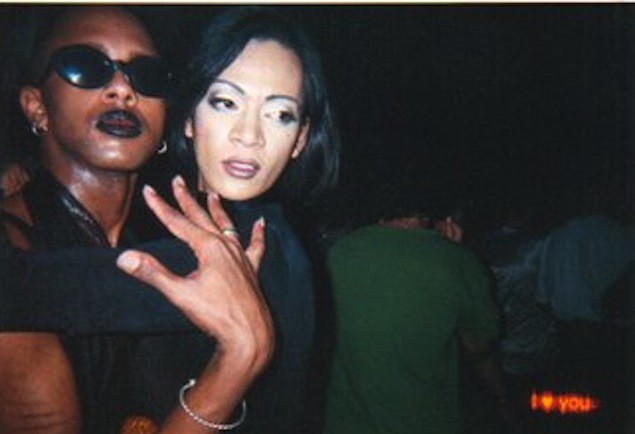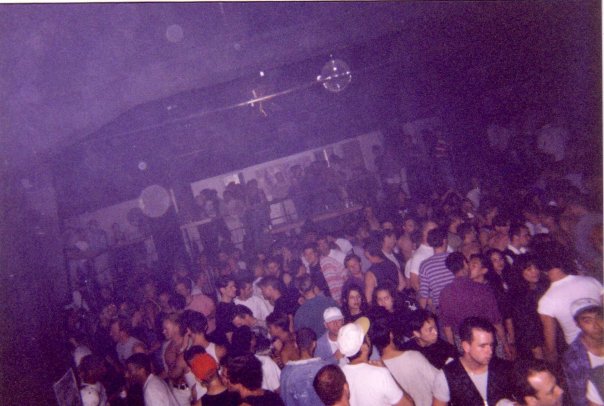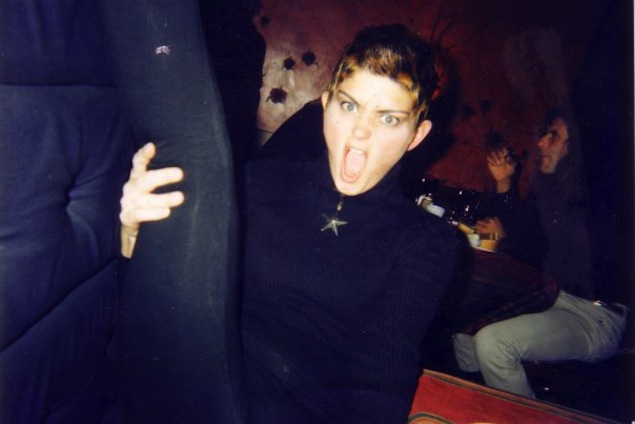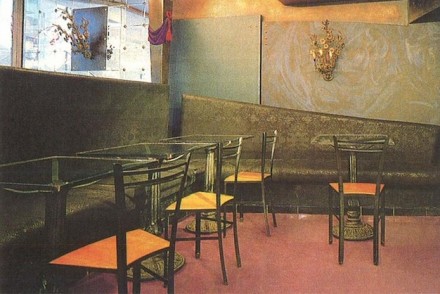Resident JOY diva and host Rommel (right). Photo courtesy of John Wulff.
Article originally published June 7, 2012 by The Grid online (TheGridTO.com).
In this edition of her nightclub-history series, Denise Benson revisits the most sexcess-ful, celeb-studded gay house club of the ‘90s.
BY: DENISE BENSON
Club: JOY, 16 Phipps
Years of operation: 1995-1997
History: The rapidly changing streets surrounding Toronto’s Yonge and St. Joseph intersection were once a mecca for adventurous late-night dancers. Some of the hub’s gay and after-hours history was explored in earlier Then & Now pieces about influential 1980s venues Voodoo and Club Z; now, we return during the ’90s, before the area was transformed by the massive condo development we see today.
The tiny Phipps Street is tucked in just north of Wellesley and south of St. Joseph, running east-west from St. Nicholas to Bay. In the mid-’70s, while big gay dance club The Manatee drew crowds to 11A St. Joseph, Club David’s brought gay revelers south down the alley, to 16 Phipps, where a gold rendition of Michelangelo’s David presided over the dancefloor. In the ’80s, David was out and mirrors were in as the building became new gay club Le Mystique.
Although it later housed a variety of warehouse parties, early raves and other one-off events, the building still featured some of Mystique’s décor when John Wulff and silent partners went to view 16 Phipps early in March of 1995. The former storehouse, complete with its old loading dock and a small tunnel that connected it to 11A St. Joseph (it’s thought a conveyor belt once ran between the two), was in rough shape.
Wulff—who’d been socializing “seven days a week” in Toronto’s downtown gay scene since he was 16, and had worked for clubs including Gilles Belanger’s B-Bar—was ready to produce something of his own. He saw the 6,000 sq. ft. space as being well-suited to his vision of an after-hours dance club, located near the gay village, that would feature house music, art, and performance.
“The space was big, raw, and warehousey,” recalls Wulff. “We ripped everything out, soundproofed the walls, sprayed everything black, and installed a sound system.”
“Physically, JOY was a big black box,” adds DJ Scott Cairns, who would become the club’s Saturday night resident. “It was mainly dancefloor, with a raised area in the back where people could get a bird’s-eye view of what was happening below. It was dark and sexy. The lighting was minimal, with the focus being the giant disco ball in the centre of the floor.”
JOY opened its doors at 1 a.m.—then last call at licensed bars—on Friday, March 17, 1995. Although the promotion of Fridays faltered at first, JOY’s Saturdays were an immediate hit and soon regularly exceeded the legal capacity of 472 people.
“JOY quickly became the late night go-to spot,” says Cairns. “Mainly a gay event, the Saturdays were heavily attended by a wide cross-section of people: drag queens, muscle boys, dykes, models—all the usual suspects—with a gay-positive hetero element. Straight girls and their terrified boyfriends were often on hand.”
Why it was important: The timing of JOY could not have been better. As a gay-heavy, house music focussed, late-night dance club, it filled a lot of gaps. The warehouse scene had slowed, raves had grown larger and younger, and the music at Toronto gay bars had become increasingly commercial.
“JOY was completely on its own,” says Wulff. “The gay clubs, like Boots, Colby’s and The Barn, were playing Top 40 with the occasional house song while raves were playing Euro-ish fast beats. JOY was playing the newest and best underground house music, and felt like warehouse parties in Chicago or Detroit. JOY didn’t feel like Canada; it felt very New York, and people were very excited to be part of the energy.”
“JOY was very important at the time as it offered an after-hours experience that was safe and close to home for a big portion of the gay community,” adds Cairns, a 30-year DJ veteran who, by then, had wrapped up popular residencies at both The Phoenix and OZ.
“There was a definite thirst for something new in the core. I feel we provided that big time.”
“The JOY space had cachet from being a gay and alternative club over many years,” says James Vandervoort, better known as James St. Bass, a friend and frequent DJ partner of Cairns’. Vandervoort had come out while dancing in nearby ’80s clubs like Stages, Avalon, and Voodoo, and had himself brought gay clubbers west of Yonge while DJing boys’ nights at both Go-Go and Boom Boom Room.
“By the time JOY got started, it felt like coming home to gay after-hours dancing, but it was our time and our generation that was running it. JOY took the tradition of those earlier after-hours dances, but had more glamour, energy, and perhaps danger than the others that came before. It was raw, dark, sexy and, best of all, so central. JOY had the sound and feel of an illicit warehouse party, but was there every weekend—and with no chasing phone-line prompts to find it!”
Cairns created much of the atmosphere with his music, often playing five full hours of the house he loved.
“Some of the best house was coming out in 1995 to ’96,” Cairns enthuses. “Big records for me at JOY included tracks from Farley & Heller a.k.a. Roach Motel, like ‘Wild Luv‘ and ‘Work 2 Doo.’ The dub of Joi Cardwell’s ‘Jump For Joi‘ was massive, as was H2O’s ‘Satisfied (Take Me Higher),’ and Robbie Tronco’s ‘Walk for Me.’ Tracks from producers like Danny Tenaglia, Roger S., MURK, Angel Moraes and Mousse T. were really big.
“And then came Boris Dlugosch and ‘Keep Pushin’,’” Cairns continues. “My friend Mitch Winthrop had just came back from visiting Boris in Germany, and arrived at JOY with a test press of this forthcoming single. I dropped it immediately and the reaction was intense. Later, in June of 1996, I had the pleasure of being joined by Boris at JOY. During his set, he dropped Giorgio Moroder’s ‘Chase.’ It’s one of my strongest memories from the club.”
LISTEN: Scott Cairns Live at JOY
The intense atmosphere of Saturdays at JOY can also be attributed to the dreams and antics of host John Wulff.
“My responsibility was to create an experience every week, and I’m proud of the events we put together,” he says.
For Halloween of 1995, Wulff performed as Carrie, complete with wig, white dress, pyrotechnics and Gilles Belanger as his Tommy Ross.
Another week, he recounts, “I rode into JOY on a motorcycle, in a star-spangled bikini, wrapped in an American flag and did Sandra Bernhardt’s strip tease from Without You I’m Nothing to [Prince's] ‘Little Red Corvette.’”
Frequently, Wulff could be found lying on a bed placed in the middle of the club on a scaffold.
“It was a mattress with gold satin sheets where whoever was feeling it would lounge or simulate sex shows,” says Wulff. “Various guests starred on that bed, from me to porn stars to beefcake male gymnasts stretching in silver sequin g-strings.”
He also recalls that JOY’s New Year’s 1996 party was perhaps the height of their (s)excess.
“We re-did the interior from black box to a glamorous ’30s speakeasy,” Wulff explains. “We installed two large chandeliers, and had an artist paint a 27-foot-long Tamara de Lempicka naked-woman portrait. We squeezed 1,200 people into that room. It was raining from the sweat and condensation—everyone was pretty much naked. I’ve never felt energy like that.”
Wulff, in fact, starred alongside the many local and international celebs who passed through the club’s doors on weekends. Dozens of actors, models and musicians took part, ranging from Madonna and her tour dancers to Alanis Morissette, Terrence Trent D’Arby, John Goodman, Geena Davis, Montreal supermodel Ève Salvail, 90210 star Kathleen Robertson, and Heather Tom of The Young and the Restless, a soap widely adored by gay men.
But it wasn’t just Saturday nights and celebrity cameos that made JOY special. About a month after the club opened, Fridays were properly launched, with Jennstar at the helm. The promoter and hostess had already worked for years at Queens Quay nightclub RPM, was a columnist for TRIBE magazine, and was known for bringing warehouse heads, clubbers, and ravers of all sexual orientations together.
Jennstar recruited fellow Futureshock crew members Gavin Bryan and Nnamdi Gryffyn a.k.a. DJ Gryphon, and they assembled a team that brought the Friday night concept called “Jennstar…She’ll Make You Famous” to life.
“We were inspired by fashion, fabulousness, fierceness, all the F words—including ‘famous,’” says Jennstar. “Everyone who attended JOY was fierce in their own way. This was a time when a lot of people were just starting their businesses—hair, make-up, graphic artists, performers, club-kids, you name it.”
Opening night was packed, with NYC’s Frankie Knuckles on the decks and Jennstarr performing as Sunset Boulevard’s Norma Desmond. Fridays consistently bridged crowds and communities, with ace rotating resident DJs Gryphon, Jason Hodges, Matt C, Mario J, and Kenny Glasgow working their musical magic.
“I remember walking down the alley, hearing the music get louder as you’d approach, and then turning the corner to see a lineup of people trying to get in every week,” recalls Hodges of his first real residency. “It was a rush.”
“JOY was a place where that warehouse vibe was strong,” adds Hodges, a now-established DJ/producer. “The sound was big, and the vibe was dope. It was a solid night that drew music-driven crowds who knew what was up.”
Most of Fridays’ cast of players—from door staff to DJs and dancers—very much knew what was up. Many would form the core of Industry Nightclub, which opened about a year and a half after JOY.
One of these people was Rommel, a house-music lover who danced many weekends away at JOY, and frequently hosted Fridays’ VIP room.
“JOY was my version of Studio 54,” says Rommel. “Favourite memories include Frankie Knuckles playing an amazing set, Franklin Fuentes performing his club hit ‘If Madonna Calls,’ and, of course, our very own Jackae [Baker], with her many fabulous performances.”
“Jennstar, Rommel, and Jackae brought the glamour and the fun,” says Vandervoort. “It was decadent for sure, but also very funny. There were feature shows and drag-fashion fabulousness that got sloppier the later it got, so it never had the heavy dark feeling of some raves; it was more pure gay lasciviousness and bold fun. You could be any orientation and be welcome at JOY, but you likely had a better time if you liked to take most of your clothes off and dance like a maniac.”
This video, with original JOY footage shot by Rob Cluff in August of 1995, serves as evidence.
“At JOY we got away with a lot,” agrees Jennstar. “There were no rules really back then. Warehouse parties had died and the cops were paying attention to the raves, so we skirted under the radar for quite a bit. Just a bit, but boy was it fun. JOY was a place where you could come and hear fierce music and be who you wanted to be. It was definitely a birthplace for many events and parties that followed.
JOY was named the Best Nightclub of 1995 in Toronto Life magazine. It also helped bring deeper shades of house back to gay bars.
Wulff offers this tidbit: “Colby’s opened Voodoo Lounge one year after JOY, and copied it directly.”
Who else played there: Jennstar’s Fridays featured many guest DJs, with a heavy Montreal lean. Frequent visitors included Luc Raymond, Christian Pronovost, and Alain Vinet, now Musical Director for Cirque du Soleil.
“The biggest international artists who played JOY for us were Deep Dish,” says Jennstar. “It’s kind of a funny story. Ashley from [promotions crew] Better Days called to ask if they could come and play the night before the [Better Days’] rave; the Deep Dish boys really wanted to get a feel for the city. I said sure, but had no real idea who they were, and we didn’t have money to pay them. They showed up and rocked the house.”
While Saturdays at JOY were mainly a showcase of Scott Cairns, guests like Montreal’s Mark Anthony and Sylvain Girard were sometimes found. Matt C also guested one Halloween, as caught on film above.
JOY also occasionally opened its doors on other nights for special events, including a House of Trance Wednesday series produced by Don Berns a.k.a. Dr. Trance.
What happened to it: JOY closed abruptly in early 1997.
“I had a falling out with my partners,” shares Wulff. “They changed the locks, and changed the name of the club to the Cubicle. Also, I was very tired and didn’t want to fight it. The fire department was all over us for capacity and sound issues, plus [then City Councillor] Kyle Rae was not a fan and wanted us closed.”
The Cubicle was short-lived. After it closed, 16 Phipps opened very briefly again under the name of JOY, though Wulff was not involved. According to him, the building was demolished roughly five years ago. In its place stands the 20-storey condo build on the south side of Eleven Residencies at 11 St. Joseph.
Wulff left the club business after JOY, moving into corporate branding and marketing. After recovering from serious health issues in 2011, however, he decided to “come out of retirement to do quarterly events,” beginning with a JOY reunion this Friday (June 8). Many of the JOY faithful will congregate in the rooms of Buddies In Bad Times Theatre (12 Alexander Street). Mark Falco DJs in the Cabaret, while Scott Cairns plays the main Chamber.
“I’ve been crafting the music for this night for months,” says an excited Cairns. “I’ve listened to probably a thousand records, trying to trim it down to the perfect set. I hope everyone has the best time, reuniting with friends and reliving the glory days of JOY.”
LISTEN: SCOTT LIVE at JOY mix 2
Jennstar, James St. Bass, Rommel and fellow JOY devotee Charles Pavia will host, while artists Drasko Bogdanovic and the Young Astronauts provide a wall of projections.
“With the reunion, it’s the old JOY mission: house music combined with artistic expression, through striking visuals, but on overdrive,” says Wulff. “I want to provide not only a good house-music party, but one that leaves you visually in awe.
“Also, Rommel will perform at 12:30 a.m., in something that I’ve described as her ‘Madonna Super Bowl Halftime Show.’ She’s accompanied by four clones of herself—you will die!
“I think that people are ready to have a different experience in nightclubbing,” summarizes Rommel. ”I would encourage attendees to put on their best boogie shoes, and to be as outrageous, if not courageous, in your club couture. JOY was especially known for that. Above all, I encourage everyone to just be you; that’s what JOY was and is all about.”



















2 Comments
Looks fun! great photos as well…
All comments in the string below have been republished from their original appearance on The Grid website. We’re including the readers’ comments as they add to these Then & Now stories. We look forward to reading new comments here as well.
Garebear
i would love to see an article on the then and now of Club Colby’s. I spent much of my money and youth there. 1:09 pm on November 13, 2014
Douglas
MISSING A LOT OF TRUTH! There is so much more to this story 4:40 am on October 9, 2013
jake
I lived the times of David night club …the Manatee….Studio II ….the Barn…The Carriage House….I was a famous performer “Vicki Sue” in all. Most importantly, those places were what natured us and engulfed us to a community. 4:12 am on November 11, 2012
Jennstar
As always Denise you have captured a moment in time that was incredible! Thank you! Jennstar xo 5:29 pm on June 8, 2012
Don Berns
The first picture just brought back one of the great memories I have of music in Toronto. The Eros party was where I witnessed Mark Oliver walk in with a bag of records he had purchased THAT DAY at Play de Record, pull the records out and play a flawless set. At that point in my life, I had to “live with” new music for several days before I even knew if I wanted to play it, but Mark didn’t have to do anything more than audition tracks at the store, put them in a plastic sack, and then know instinctively how they would fit together best. He became my DJ hero that night, and doing what he did became my goal. I came sort of close to achieving that goal…once. 3:12 pm on June 7, 2012